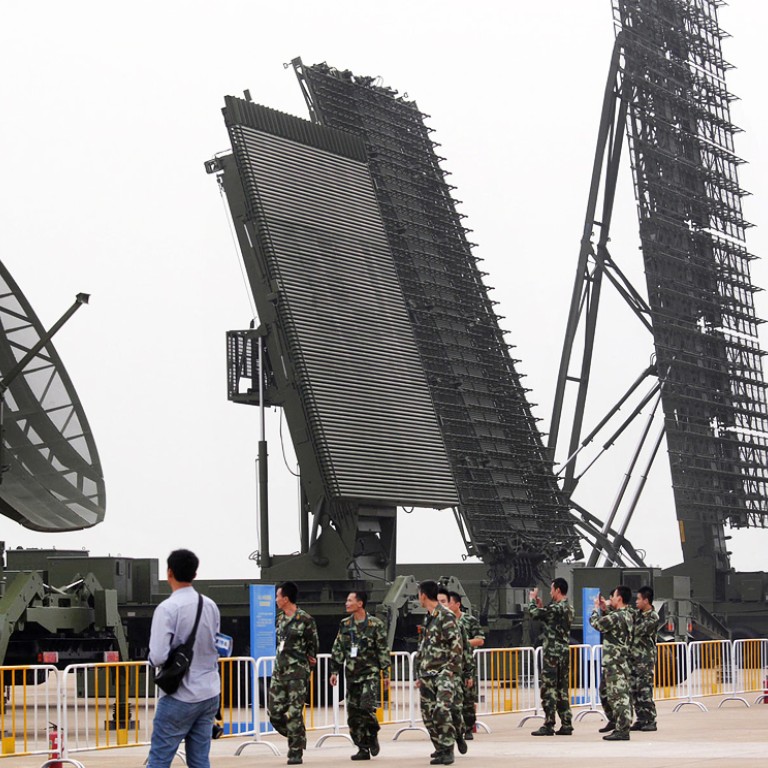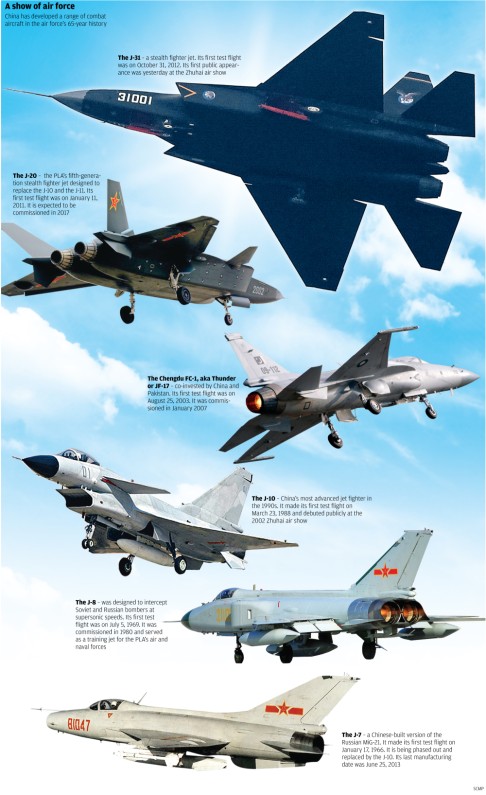
Space to be the next frontier for China's air force
The PLA's airborne wing has been told to regroup and push new aeronautical limits but one big technological challenge bars the way
When the wraps came off the J-31 stealth fighter at the Zhuhai air show yesterday, there was double cause for celebration for the People's Liberation Army Air Force. It not only marked the public debut of the country's the fifth-generation stealth fighter, it represented the progress China has made in the 65 years since its air force first got off the ground.
The J-31 is just one of a series of fighter jets to roll off mainland military production lines in recent years. Despite the advances there remains one gaping hole in China's winged military industrial complex - one that could stop it from realising the next mission set for it by the highest echelons of power.
Whatever their individual missions, the various jets fighters and aerial drones are building blocks for China's aim to push the next frontier - space.
In June, President Xi Jinping , who is also chairman of the PLA Central Military Commission (CMC), told the air force to upgrade and accelerate its integration with the country's space programme to keep up with what was the main goal of advanced air forces around the world, Xinhua reported. Xi said the air force had to complete the integration within five years, allowing China to showcase the achievement on the 70th anniversary of the founding of the people's republic.
Watch: China's Zhuhai airshow takes off, J-31 fighter makes debut
This target came after the Centre for National Defence Policy, a part of the PLA's Academy of Military Sciences, released a report in April which said that in the last 15 or so years, security threats from space had increased in China.
"Some countries have sped up their development of space forces, intensified their competition for military superiority in space and ramped up their efforts to develop offensive and defensive space weapons," the report said.
It said that some space superpowers had developed all-weather, near real-time and high-precision cameras to collect data on China's military, political, economic and technological abilities, resulting in a constant threat from space to China's national security. Those space superpowers were not named but military experts say the report pointed to the United States.

"So far we don't know whether Beijing will follow the US or Russia in air-space operational command," Professor He Qisong, a defence policy specialist at Shanghai University of Political Science and Law, said.
He said the air forces in both the US and Russia played lead roles in their countries' air-space operations. In the US, the Air and Space Operations Centre is the air force senior agency commanding air and space operations. In Russia, air defence forces merged with the strategic missile corps in 1998, coming under the air force to become one of three air-space combat units.
But, the Chinese air force had not played a key role in air and space defence preparations because generals from the ground forces still dominated the PLA's leadership, He said.
"Only two of the 10 military generals of the CMC leadership came from air force," He said.
He said the air force did not take part in satellite launches or strategic missile development projects. "The air force is only responsible for choosing potential astronauts from its pilots, and astronaut training is then passed to the PLA's General Armaments Department."
Military observers said the PLA needed a clearer direction on air-space integration due to the fierce competition among world powers in outer space.
"The next major challenge for the PLA to achieve a better joint force outcome is to figure out how it will manage warfare in outer space," Rick Fisher, a senior fellow at the International Assessment and Strategy Centre, a US-based think tank, said.
"All of the major space stakeholders in the PLA are vying for leadership of a future space force as they all build their respective capabilities, but it does not appear that the Chinese political leadership is ready to make fundamental decisions just yet."
One of those fundamental problems is technological - China still can't make its own aircraft engines.
"There is a cruel fact: almost all the PLA Air Force's advanced fighter jets … are still powered by Russia-made engines although Beijing has [made] serious investment in engine research and development," Andrei Chang, Hong Kong-based editor-in-chief of the Canada-based , said.
"Aircraft engines are a key technology that the US and Russia developed as they industrialised. It took Russia 100 years to get this far and the United States 80 years. Moscow definitely won't pass on such a core technology to Beijing."
China took at least 10 years to develop the J-10, its third-generation all-weather jet fighter and the air force's mainstay. But the development of its home-grown carrier-based fighter jet, the J-15, took just three years.
However, just a small number of the air force's J-11Bs once used the home-developed WS-10A engine, which is a copycat of the Russian AL-31F, Chang said. But after too many accidents, the air force went back to the Russian original. Professor Arthur Ding Shu-fan, the secretary general of the Taipei-based Chinese Council of Advanced Policy Studies, said the engine problem would not only harm the country's air defence, but also its long-term aviation development.
"China is going to open the overseas market for its J-31, meaning it will need to share the market with another competitor - Russia, [which] produces engines for the J-31," he said.
Chang said a lack of creativity among the Chinese military leadership was to blame. "The Chinese leadership encourages a copycat culture because it just wants to see effects quickly, and the J-10, J-11 and other Jian series fighter jets are all copies of Russia's Su-type aircraft," he said. "The air force will only become a real modern aviation combat force when China has its own indigenous weapon designs."

